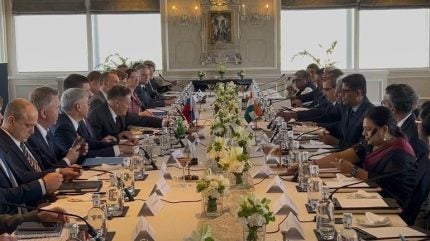
Russia and India will urgently develop new joint projects for both large and small-capacity nuclear power plants (NPPs) and strengthen cooperation in the nuclear fuel cycle, according to a Rosatom statement. This followed a meeting in Mumbai between Rosatom director-general Alexey Likhachev and the head of India’s Department of Atomic Energy, Ajit Kumar Mohanty.
According to the statement: “particular attention was paid to the possibility of localising equipment production” in India. The two countries reaffirmed the value of the collaboration developed through the Kudankulam NPP project in Tamil Nadu and their willingness to launch new strategic initiatives in the nuclear energy sector. Kudankulam is the largest NPP in India, and the flagship project of Russian-Indian technological and energy cooperation.

Discover B2B Marketing That Performs
Combine business intelligence and editorial excellence to reach engaged professionals across 36 leading media platforms.
The Kudankulam NPP will comprise six units with VVER-1000 reactors. Work began following an intergovernmental agreement between India and Russia signed in 1988. Units 1 and 2 (phase one) are already in operation and work is under way to build units 3-6 (phases two and three). The customer and operator of the station is the National Power Company of India (NPCIL), the general contractor is JSC ASE JSC (Rosatom’s Engineering Division), the general designer is Atomenergoproject and equipment design is provided by OKB Gidropress.
Units 1 and 2 began operation in 2016. The general framework agreement with Rosatom on construction units 3 and 4 was signed in 2014 and, in 2017, the engineering division of Rosatom and NPCIL signed an agreement on construction units 5 and 6. Work on units 5 and 6 began in 2021 and the NPP is expected to be operating at full capacity by 2027. The road map for nuclear cooperation between Russia and India provides for the construction of a total of 12 units in India, including 4–8 at Kudankulam.
Rosatom’s fuel company, TVEL, supplies India with advanced nuclear fuel, TVC-2M, which offers new capabilities for the Kudankulam plant. This allows it to operate for an 18-month fuel cycle, improving its economic efficiency compared to the traditional 12-month cycle.
“Russia and India are connected by long-term and mutually beneficial cooperation in the nuclear field,” said Likhachev. “The Kudankulam project laid the foundation for our partnership and opened the way for new joint initiatives and technological exchanges. We have built an effective interaction system and a reliable supply chain, which has become the basis for the further development of new projects – whether high-power or low-power plants.

US Tariffs are shifting - will you react or anticipate?
Don’t let policy changes catch you off guard. Stay proactive with real-time data and expert analysis.
By GlobalData“Today, India sets itself an ambitious goal – to increase nuclear generation capacity to 100GWe [gigawatt-electrical], and Rosatom is ready to make its contribution by offering effective technologies that have demonstrated their reliability in Russia and abroad.”
Russian organisations are now developing technical specifications for a new NPP in India featuring advanced VVER-1200 reactors, Rosatom said in its statement. The two sides are also discussing new areas of cooperation, including the construction of small modular reactors of Russian design in India.
“Relevant organisations are currently developing technical specifications for a new nuclear power plant in India featuring VVER-1200 reactor units,” the statement said, describing the serial construction of high-capacity nuclear power units of Russian design, based on VVER-1200 technology, as one of the key areas of cooperation.
“New areas of cooperation are also under discussion, including the construction of small modular reactors (SMRs) of Russian design in India. In April 2024, Rosatom presented its Indian partners with information on the corporation’s floating nuclear power solutions,” the statement said.





